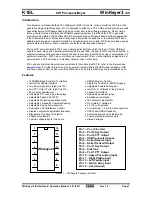MPC563XM Reference Manual, Rev. 1
Freescale Semiconductor
861
Preliminary—Subject to Change Without Notice
knowing TCR1 value during the service time, and TCR1 value captured in the EAC channel due to the
physical tooth pin transition. The duration of the Halt mode is obtained using the estimated tooth time.
Figure 23-62. Halt Mode - Deceleration
23.4.7.5.3
High Rate Mode (Acceleration)
In case of acceleration, the next tooth arrives before the Tooth Tick Counter reaches the TICKS value. In
this case the High Rate logic is responsible for closing the gap and advancing the tooth on the correct
timing. The High Rate mode operates as follows:
•
When the acceleration is detected (physical tooth arrives before the Tooth Tick Counter reaches the
TICKS value), the Count Control and High Rate logic switches to High Rate mode in which both
the Tooth Tick Counter and TCR2 count at rate of system clock divided by eight, until the Tooth
Tick Counter reaches the current TICKS value. To ensure correct operation, the TICKS value is
sampled in the logic at the beginning of the mode.
•
At this point, which represents the estimated tooth edge, the logic resets the Tooth Tick Counter
and advances TCR2 (or resets it if LAST is asserted and MISSCNT = 0).
•
The control logic switches back to Normal Mode, using the most updated TRR value as input to
the Angle Tick Generator. The logic samples the updated TICKS value for the tooth estimation,
last tooth indication and number of missing teeth from TPR.
In High Rate mode the angle ticks are provided at high speed until the end of the current tooth. This
operation is required to scan all the valid angle values of the current tooth, in a rate which is not too high
for the Red Line bus continuous update, but much higher than the rate dictated by TRR.
EAC channel microcode, which services the physical tooth transition detection, can start its service either
before High Rate mode operation is complete (the Tooth Tick Counter has not reached the TICKS value)
or after the EAC switched back to Normal mode. Any physical teeth received while the EAC is in High
Rate Mode does not alter the immediate EAC state, but it is still detected by the EAC channel logic and
can, therefore, alter future EAC behavior (for instance, closing the tooth detection window - see
Section 23.4.7.10, “Angle Logic and Channel Modes
Tooth Signal
Angle Tick
TRR
P1
P2
P3
P4
EAC Channel
Service Time Slot
EAC Channel
Capture
TCR1
TCR1
TCR1
TCR1
P1/ n
Ch0
y
y+n
y+n+1
Ch0
Ch0
P2/ n
Halt Mode
*service request
**microcode updates TRR
*
*
**
**
TCR2 - continuous
Tooth Tick Counter
0
0
0


















